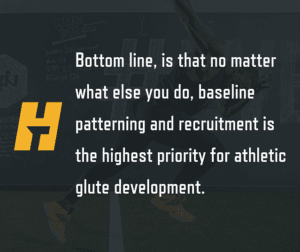5 Movements to Build Powerful Glutes and Hamstrings for Athletic Performance
Sports Performance | Strength & ConditioningABOUT THE AUTHOR

Joel Smith
Joel Smith, MS, CSCS is a NCAA Division I Strength Coach working in the PAC12 conference. He has been a track and field jumper and javelin thrower, track coach, strength coach, personal trainer, researcher, writer and lecturer in his 8 years in the professional field. You can connect with Joel on his website.
We all know things like deadlifts and Olympic lifts are great general posterior chain builders, so I’m going to leave those movements for now in favor of some more over-arching philosophy.
What I want to focus for my take on this subject are some fine points of building the glutes and hamstrings that I believe form the foundation of athletic development. Everything else runs off of what the purpose of these exercises are, which is building effective athletic patterns. Take an athlete with good patterns, and have them sprint, lift, and play sports, and you’ll get big glutes and strong hamstrings.
The 5 points below will also help athletes to get more posterior chain contribution to the everyday squatting, deadlifting and Olympic lifting they might already be doing.
1. Sprint
It goes without saying that the best way to build glutes and hamstrings for athletic performance is to sprint maximally and regularly. In sprinting, when the foot is on the ground, the glutes will reach their maximal contractile force, the peak of which will exceed most anything done in the weightroom.
Things are different when the free leg is swinging through the air. When sprinting, during “swing-through” when the swing thigh comes forward, and the shin positions itself to bring the foot down to the track, the forces on the hamstring are immense. This is because the hamstring must act eccentrically to dynamically decelerate the shin, and allow the leg to be brought down in a good position.
Physiologists have estimated the peak internal load on the hamstring in this situation to be up to 10x bodyweight, the original “leg curl”.
It has been said that during sprinting, athletes will access muscle fibers that are unavailable during any other movement. In other words, there are muscle fibers you can’t hit in the weightroom, that you can hit while sprinting hard.
Strength coach legend, Buddy Morris, has said that sprinting is the best possible hamstring exercise that someone can do. UK coach Greg Potter has told me that the power clean maxes of his athletes tend to go up during the competitive track season due to the high intensity sprint work they are getting by sprinting in states of maximal arousal.
Since speed can improve strength, but not always the other way around, it’s important to be hitting the speed end of the spectrum regularly to ensure optimal athletic development.

2. Hill Sprints or Heavy Sled Sprints
If you want to put a little more emphasis on the glutes, and less on the hamstrings, go find a hill to run up. You can also choose a heavy sled to pull, as research is now showing that heavy sled training can do wonders for athletes who lack force in acceleration.
When hill training, the angle of the hill takes some edge off the hamstring requirement, and allows athletes to hone in on building glutes, due to the overall speed of movement, and direction of the swing leg.
3. Butt Bungee Drills, and Band Resisted Sprint Movement
By attaching a band to the hips, providing tension from the rear, any exercise can instantly be turned into a prime-time glute developer, including deadlifts, RDL’s, and even squats.
The body will adapt and react to stressors placed upon it, so by attaching a cord that the body mustrecruit extra glute muscles to pull against, literally any exercise can be modified to recruit more glutes in a dynamic fashion. The videos below demonstrate a simple adaption of this method, which can be applied to virtually and lift or sport movement.
Finally, here is a video from the master of muscle patterning, Douglas Heel showing his “butt bungii” system.
4. Yessis Glute Ham Raise and Nordic Hamstring
As you heard me mention in point #1, the hamstrings undergo massive eccentric forces in decelerating the swing shin. Because of this, specialize in exercises that
- Train the hamstring eccentrically and/or
- Train the hamstring bi-articularly
When I say the hamstrings are bi-articular, I mean they attach at two points; the hip, and the shin. Only one hamstring, the biceps femoris, directly connects the femur to the shin. The job of the hamstrings in sport movement (aside from isometric pursuits, such as wrestling or rock climbing) is actually not to create force on its own, but rather to transfer force between the hip and shin.
This being said, the hamstring is a smart muscle, where the glutes are a bit more “dumb” (they just fire hard when the foot hits the ground, or a few milliseconds before it in pre-activation)
To this end, there are two nice exercises that fit the bill in improving hamstring strength and functionality, the glute-ham raise, as taught and invented by Dr. Yessis, and the Nordic hamstring.
The Yessis Glute-Ham raise trains the hamstrings from a bi-articular standpoint, as an athlete will put their hips a few inches off of the GHR pad, loading the hamstring at both of its attachment points, ad making it dynamically control length between the hip and shin.
The Nordic hamstring has been written and raved about by many coaches and researchers for years, and for good reason. It has been researched to significantly reduce hamstring injuries in athletes. It is suggested that this works due to the ability of the exercise to increase the peak eccentric force of the hamstrings at shallower angles of knee flexion (the knee is more extended) vs. a leg curl which puts a premium on concentric force when the knee is in full flexion.
5. Barbell Hip Thrust
A general exercise for glute building that I’ve found quite effective is the barbell hip thrust. I can say this from not only a strength perspective, but also a functional perspective in sprinting. After a few months of barbell hip thrusts, I’ve seen sprinters get faster, and exhibiting better mechanics at the end of races, as their glutes are able to stay coordinated and powerful longer, which keeps them from recruiting too many accessory movers and losing movement quality.
I find that to maximize the effectiveness of the hip thrust, focus on holding the top position for a few seconds while belly breathing. I also have found that being able to do 5 plates isn’t so much the key to this exercise so much as being able to do with proper drive from the glutes (not feeling your hamstrings in the lift), as well as maintaining proper breathing mechancis.
Bonus: Get Therapy and Play Your Sport
Therapist John Gibbons has highlighted that not all hip extension is created equally. When lying on a table, and extending the hip, an athlete should have a pattern of
- Glute fires
- Same side hamstring fires
- Opposite site quadratus lumborum fires.
#1 and #2 can happen at the same time, but definitely NOT hamstring before glute. You can see how Gibbons tests this in the video below.
Many athletes do not recruit hip extension according to this pattern. The crazy thing is that often times, too much heavy barbell work can actually make this pattern dominated by the hamstrings and back (because of the need to brace a barbell), rather than “glute first”.
In fact, probably the most off-timed pattern I’ve seen was in a very high level CrossFit athlete, who had a great standing vertical jump, but couldn’t get any higher with any approach (due to quad and spine dominated movement, powerful, but slow). If you can’t time the glutes properly, it’s hard to convert momentum into upward movement with much efficiency!
In the Just Fly Performance Podcast, French researcher JB Morin talks about how Olympic weightliters are incredibly fast over a short distance, say 20 yards, but after this, they start to slow down significantly, because they can no longer apply horizontal force to the ground effectively; all power is being used up to supply the vertical force requirements. Fast athletes over 30, 40 and 50 meters can apply horizontal force to the ground at faster speeds. I strongly believe that much of this is due to the patterning of the way the body recruits the glutes, hamstrings and quadratus lumborum sequentially for speed.
When I asked Boo Shexnayder, educator to the NCAA track and field coach contingent, about building glutes for athleticism, he actually favors the effect that good therapy can have on getting glutes active, and then doing the standard battery of weight room movements, jumps and sprints, rather than trying to overly specialize on glutes in the weightroom.

Bottom line, is that no matter what else you do, baseline patterning and recruitment is the highest priority for athletic glute development. When a muscle is firing hard to drive movement, it gets big.
How do you improve the quality of firing patterns if you don’t have a therapist? There are plenty of therapy tools and substitutions available, but ultimately, I have benefitted the most from learning the work of Douglas Heel through “Be Activated”, and applying this to everyday training.
I feel that the world of breath and breathing training has a lot to offer, as well as low-intensity isometric exercises in cases of a shoestring budget. Simply doing strong diaphragmatic breathing during routine sets of squats and deadlifts helps to get more glute and hip flexor activity in the movement through fascial links of the diaphragm.
I say all this not to downplay strength training at all, but merely to keep everything in perspective. Like the quote goes in the movie “The Big Short”, “Truth is like poetry, and most people f#$^% hate poetry”.
Are you a better coach after reading this?
More coaches and athletes than ever are reading the TrainHeroic blog, and it’s our mission to support them with useful training & coaching content. If you found this article useful, please take a momemnt to share it on social media, engage with the author, and link to this article on your own blog or any forums you post in.
Be Your Best,
TrainHeroic Content Team
HEROIC SOCIAL
HEROIC SOCIAL
TRAINING LAB
Access the latest articles, reviews, and case studies from the top strength and conditioning minds in the TH Training Lab

